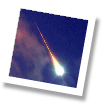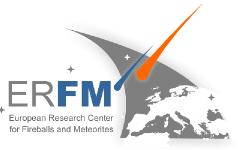Our experiences with large meteor phenomena
Our experiences with witnesses All over the world there are only very few specialists, who are explicitly engaged in fireball- respectively bolide-phenomena and their forms of appearance. We from the ERFM can use our particular experiences in this area, which we have gathered continuously since 2000 in time-consuming interviews with witnesses in Europe. Thereby in the course of time one has managed better and better to document witness reports methodically in respect of suitabilty for scientific implementation.. Because there is a main problem with these statements: the irreproducible element of error. What about the accuracy of each report? In order to be able to clarify this most important question, first and foremost we must collect the relevant data from the mostly unknowing and astonished witnesses of the event, and we just should do this as accurately as possible It is never a trivial challenge to accomplish this and is only possible within a personal and detailed interview, in which correct and clear words must be found for understanding between witness and scientist. This is the main source of errors and misunderstandings. From the very short-time observation of a witness at an event we can expect only subjective descriptions of what the witness really observed. By and by and with the newly gained knowledge of the witness a statement definitely can alter in a dynamic mode. Purportedly, you can only see consciously those, which you are able to interpret by yourself in an adequate way. And exactly in that way you can hear the reports. That is then no failure in the observation itself, but it is only in the quality of the used vocabulary.
Witnesses and the event However in densely populated Europe we have the advantage to get the opportunity to pick rather a lot of witness reports to an event. Needless to say is the fact: To err is human! But if people, who do not know each other and whose fundamental knowledge may be in fact very different, so if these people report similar running events, then these details were really observed in this way. These courses of actions we get from reports of various and partially very interesting perspectives. With that we can often find out much more new and important than it will be possible for the scientific and technical equipment (which was build for that purpose) mostly from a large distance to the event. At the ERFM we notice regularly with each large meteor event, how unconditionally witnesses commit themselves to the altitude, distance, velocity and the size of the object, although they were not able in any way to really observe or estimate this. So it happens very often, that an event is considered as “very closely”, if it is occurring apparently rapidly at the horizon. In fact it is even then very far away. In newspapers and Internet discussion boards you can read such blind statements like: „The meteorite is definitively fallen on the adjoining meadow, because the fireball came very deep and arguably crashed over there!...” Nevertheless also this witness observed very much interesting facts. One must only ask the concrete questions and don’t let the witness talk at large. The majority of witnesses is able to specify a meteor in altitude and direction with an accuracy of +/- 2°, if the event is not just too close to the zenith. The surveys of witnesses hold by the ERFM have clearly demonstrated, that the typical witness can focus exactly only on few aspects. Considering the short time of an event, the witnesses will rather vaguely perceive the rest. In return they have rather fewer problems to describe accurately the chronological order of circumstances. Only about the duration of time by itself they don’t keep control. Few seconds become minutes or vice versa. Affected by the spectacular impressions the people think of the time too late in order to calibrate chronologically the experienced event. It also will be very difficult to specify the apparent magnitude, because the observer can barely use experiences or the few reference values from the nature.
Records of spectacular meteor events We realise the fact, that in general the observing people are frequently enabled to document an appearance of a meteor by chance. For example there are more and more surveillance systems, which could record by video such an event. Certainly one is always surprised by an event, but how quickly one is taking a picture of a daylight meteor or a meteor cloud, which one actually cannot see only one second. Likewise the possible detonation after a spectacular meteor appearance one can hear only in approximately one minute or more after the event. Also in the sequence of these noises there is important information. Those period, which is passing by between the meteor appearance and the acoustic appearance, should actually be long enough to prepare oneself and to take a meaningful picture. However until now there are extremely few records of sound phenomena, although the detonation affects an area, which we can always describe as an extremely expanded area with frequent radius of around 100 km or more. The cause of that is the lack of knowledge and inexperience about the fact, that a bang or a rumbling can follow the meteor appearance.
Witness, please inform us.! In the end all witnesses should be aware of the fact, that also a report, which seems to be possibly a humble statement, can become very important even in the general context. Unfortunately only few witnesses file a report of a fireball event. However we are depending just on these observation reports as well as the random pictures or video records of a meteor when it is shining from the sky or highlighting the landscape. | ||||
 | ||||
Meteoric Science

![]()
![]()


![]()






